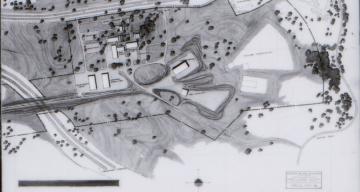Legacy SLACspeak M
M-2 Mark II Experiment.
M-3 Mark III Experiment.
MAC MAgnetic Calorimeter detector at PEP/SLAC
MAC Minority Affairs Committee.
MAC CALF A Macintosh computer used as a terminal on the VAX control system. See also CALF.
macropackage A collection of TeX macros, or definitions, that are used as a group to typeset documents following the guidelines of a specific page layout or style.
Magnetic Fusion Energy Network See MFENET.
Main AG The power supply, Main Alternating Gradient, that drives the 920 bend magnets of the SLC arcs.
MARK Name given to several generations of both accelerators and detectors created and used at HEPL and at SLAC. (See http://www.slac.stanford.edu/history/mark.shtml.)
MARK I A famous SLAC experimental detector, used to discover the PSI particle and the tau lepton at SPEAR in the mid 1970s.
MARK II First used at SPEAR as a replacement for the MARK I detector, this SLAC experimental detector was then used in region 12 of PEP during the 1980's, and again used as the SLC primary detector until November of 1990. See also MARK I.
MARK III An experimental detector used at SPEAR after Mark II.
Massimo Massimo Criteria are the orbit positions at the back end of each ARC, where the beams pass through the centers of the small- aperture fixed collimators at the entrance of the FF. The x and y orbit values are usually posted near COW 3 in MCC and in the FF SLC TODAY book. Named after Massimo Placidi, a CERN physicist who assisted in commissioning the SLC final focus.
MAT An abbreviation for MATLAB used in VAX terminology for a type of mathematical problem solving file : ` File.Mat.'
MBCD MultiBus CAMAC Driver. A Micro circuit card used to interface with CAMAC crates.
MCC Main Control Center. The building (Bldg 005) from which the accelerator is operated. Also, the actual control room within that building.
MCD Mechanical Component Design group (at SLAC)
MCR Main Control Room.
MEL-FS Multiprogram Energy Laboratory - Facilities Support.
MESSENGER MErcury Surface, Space ENvironment, GEochemistry, and Ranging mission.
Mezzanine The name of the Collider Hall second floor.
MIC Monolithic Integrated Circuit.
MICE Muon Ionization Cooling Experiment (RAL)
MICOM A Switching box to manage broadband communications between terminals (via the servers) to the VAXes, the IBM 3270 and the Ethernet network. A terminal which is serviced by the `MICOMswitch' can be used on any of the SLAC site's main computers.
Micro Microcomputer. The SLC system includes about 70 microcomputers with 8086 or 80386 multitasking CPUs. Most micros are used to a) drive CAMAC crates which in turn control accelerator devices and instrumentation, b) perform standardization algorithms for magnets, and c) communicate with the VAX by either receiving instructions or returning information for monitoring and display purposes.
Microcomputer See Micro.
Midas See MidasWWW.
MidasWWW The first fully-functional X-window GUI browser for the World Wide Web, written by Tony Johnson at SLAC. It features a multifont hypertext display, source code viewer, Motif Style Guide compatibility, and runs under UNIX and VMS. MidasWWW strongly influenced the subsequent development of the Mosaic and Netscape Navigator browsers.
MILAGRO Gamma Ray observatory at Fenton Hill, New Mexico.
Mini Sam Small Angle Monitor, used to detect Bhabha-scattered electrons in the Mark II detector.
MINOS Main Injector Neutrino Oscillation Search (at Fermilab)
MINUIT A FORTRAN numerical minimization program written by Fred James (CERN) in the 1970s.
Missing Pulse See FIDO.
MK-II MARK II Detector. The first SLC detector, replaced at the SLC by the SLD. See MARK II.
MKS MKSU Protect A klystron summary display status indicating that the MKSU went into `protect mode.'
MKSU Modulator Klystron Support Unit.
MKSU Protect See MKS.
MKT MKSU Trigger Enable Fault A klystron summary display indicating an interlock fault that causes inhibition of the modulator firing triggers.
MNT MaiNTenance A klystron summary display message. In maintenance mode the klystron may be run locally. This is accomplished by triggering the unit at a time when there is no beam present.
MOAN Modern Offline Analysis Nexus.(MARKIII)
MOD MODulator. A klystron summary display message indicating a modulator interlock fault. Each klystron is powered by a modulator that produces accurately-timed high-voltage pulses of the proper width (3.5 micro sec), amplitude and polarity, to pulse the klystron tubes. Modulators can pass 4000 A peak current, and are triggered at multiples (and sub-multiples) of 60hz by the MTG. When we speak of `triggering a klystron,' we actually mean we are triggering its modulator.
MODEM MOdulator-DEModulator. A device or program that enables a computer to transmit data over telephone lines.
MODulator See MOD.
MORE Microwave Oil Recovery Experiments.
MORSE Multigroup Oak Ridge Stochastic Experiment.
Mosaic A mouse-driven interface to the World Wide Web (WWW) developed by NCSA. (See also MidasWWW)
Mover A stepping motor used to move a magnet with respect to the beam. The beam steering in the SLC arcs is done with magnet movers instead of the more conventional `trim winding' method.
MP00 Master Pattern generator zero. A microprocessor in MCC that generates the PPYY signals.
MRK1 See Mark-I
MRK2 See Mark-II
MRK3 See Mark-III
MRKJ Mark-J detector at DESY
MTF Memorandum-To-File.
MTG Master Trigger Generator. Located in CID, this unit synchronizes the fiducial with respect to PG&E and the damping rings.
MTI Multispectral Thermal Imager
Multibus A backplane crate system similar to CAMAC or NIM designed to hold modules. SLC micros use a multibus system.
Multibus CAMAC Driver See MBCD.
MURA Midwestern University Research Association. Group working on high energy proton machine in the 1950's. Donald Kerst, Director, 1956 .
MUSASHI Monoenergetic Ultra-Slow Antiproton Source for High-Precision Investigations, a group of the ASACUSA collaboration.
MUX An abbreviation for Multiplexer.
MWC Minority and Women's Committee.

